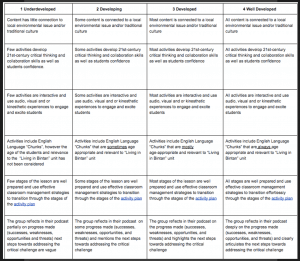Recently, Grade 10 FIB’s visited communities in Bintan as a part of a global perspectives service trip.
Our group visited a village in Bintan called ‘Pengudang’, and we learnt more about the community through focusing on the different perspectives of – nature, economy, wellbeing and society.
What did you learn about “Living in Bintan” by interviewing different stakeholders using the different Compass perspectives? Why was it important to go through this process?
There are many aspects and areas at play inside a community, so learning about the community in a more holistic way, with several perspectives, gave us a broader understanding of what is happening within Pengudang and helped us make sure that we were not placing emphasis in only one area of the community. Additionally, it aided us in better understanding how all these aspects of the life within the community co-relate, overlap and come together as a whole.
Asking different stakeholders about these perspectives was beneficial as it gave us different opinions from people with different roles in the community. It gave us more information, ideas and references.
For instance, our group met with a kite-surfing instructor named ‘Aidil’, and from hearing his perspectives on the community, we got to understand and hear firsthand why there may be financial struggles, lack of higher education and the aspirations of the youth population in the community. This helped us understand the goals of the community and accordingly adjust our lesson plans towards assisting this goal. In Aidil’s case, one of his struggles was that the lack of English communication skills prevented him from getting a job in the tourism industry, so we realised the importance of incorporating a way to develop English communication skills in our lesson plans.
Similarly, meeting with Ibu Mariani and Ibu Sakdiah also gave us important insights into community life as females. But interestingly, meeting the stakeholders helped break several misconceptions I had had about Pengudang. For example, that there is no prominent gender discrimination, more girls go to schools than boys do or that their culture is greatly important to them and will not be submissive to the rise in tourism. This allowed us to grasp the intricacies of the community and understand it better.
—————————————————————
The presentation below is the information Pranav Harish and I collected about the economy in Pengudang, Bintan
When presenting your Compass perspectives (Nature, Economy, Society and Well Being) What did you do well? What could you improve?
When presenting this Compass perspective alongside Pranav, I feel we did quite well overall. I believe this is due to various factors during the process of preparation. Firstly, we had collected appropriate information on our compass perspectives that we effectively incorporated into the content of our presentation that helped specifically elaborate on the situation in Pengudang. For example, Bintan Resort Corp. Scholarships, Perspectives of stakeholders that justified the trends spotted about the economy like Pak Madun and Pak Iwan about increasing entrepreneurship and economic diversification. This was presented in a good way due to the connection-making and cohesiveness we spotted between our trends which showed larger cultural movements and impacts within the other compass perspectives. For example, relating an increase in tourism to women in the industry and it’s effects on the larger society.
However, we could have shown a heightened level of refinement with out content through relating this to how we see trends in the economy relate to internationally or spotted more possible trends that could have shifted our views on the economy. Personally, I could have had more insightful things to add to the presentation.
When looking at my presentation skills individually, I feel like I spoke with a good amount of clarity and used hand gestures to help put across my points more effectively. However, I did fidget with my hands/hair/face and looked upward while speaking and in those aspects, I could have improved on the presentation. But mainly, I feel the good collaboration we had as a team benefited the clarity of the presentation as we had clear-cut sections for when to speak and we communicated with each other during the presentation and made sure it was connected and well-projected.

